Application of the Q-Slope Empirical Approach for Slope Stability Assessment of Spanish Mountain Roads in Winter—Combining Remote Techniques with Virtual Reality
Abstract
:1. Introduction and Scope
1.1. Spanish Slopes in Winter
1.2. Empirical Assessment of Rock Slopes and Virtual Reality Visualization
2. Materials and Methods
2.1. Study Sites
2.2. Q-Slope Addressing Ice Wedging
- RQD is the rock quality designation, which varies between 0 and 100, and if the value is less than 10, then the minimal value of 10 is used [9].
- Jn is the joint set number.
- Jr and Ja are the joint roughness numbers and the joint alteration numbers, respectively.
- The (Jr/Ja) factor considers the favorable or unfavorable orientation of the joints compared with the slope, and “O” is an adjustment factor referred to as the “O-factor”.
- SRF slope is the stress reduction factor for the slope.
2.3. Field Data Acquisition and Interpretation

3. Results
4. Discussion
5. Conclusions
Author Contributions
Funding
Institutional Review Board Statement
Informed Consent Statement
Data Availability Statement
Conflicts of Interest
References
- AtlasBig.com. Available online: https://www.atlasbig.com/en-us/countries-average-elevation (accessed on 25 January 2022).
- Escarpe, L.A. Pirineos Guía de Los 3000 m, 1st ed.; Sua Edizioak: Bilbo, Spanish, 2015. [Google Scholar]
- Martínez, M.T. Sierra Nevada: Una Gran Historia, 1st ed.; Editorial Universidad de Granada: Granada, Spanish, 1997. [Google Scholar]
- Tiempo.com. Available online: https://www.tiempo.com/ram/38719/aniversario-de-un-record-frio-en-espana/#:~:text=El17dediciembrede,Españaenunlugarhabitado (accessed on 25 January 2022).
- Infonieves.es. Available online: https://www.infonieve.es/estaciones-esqui/pais/espana/ (accessed on 25 January 2022).
- Bar, N.; Barton, N. Q-Slope Addressing Ice Wedging and Freeze-Thaw Effects in Arctic and Alpine Environments. In Proceedings of the ISRM International Symposium-EUROCK 2020, Trondheim, Norway, 12–14 October 2020. [Google Scholar]
- Romana. New Adjustment Ratings for Application of Bieniawski Classification to Slopes. In Proceedings of the International Symposium on Role of Rock Mechanics, Zacatecas, Mexico, 2–4 September 1985; pp. 49–53. Available online: https://www.scirp.org/(S(351jmbntvnsjt1aadkposzje))/reference/ReferencesPapers.aspx?ReferenceID=253061 (accessed on 25 January 2022).
- Romana, M.; Tomás, R.; Serón, J.B. Slope Mass Rating (SMR) geomechanics classification: Thirty years review. In Proceedings of the 13th ISRM International Congress of Rock Mechanics, Montreal, Canada, 10–13 May 2015; Volume 2015, pp. 1–10. [Google Scholar]
- Barton, N.; Bar, N. Introducing the Q-slope method and its intended use within civil and mining engineering projects. In Proceedings of the ISRM Regional Symposium, EUROCK 2015, Salzburg, Austria, 7–10 October 2015; pp. 157–162. [Google Scholar]
- Bordehore, L.J.; Riquelme, A.; Cano, M.; Tomás, R. Comparing manual and remote sensing field discontinuity collection used in kinematic stability assessment of failed rock slopes. Int. J. Rock Mech. Min. Sci. 2017, 97, 24–32. [Google Scholar] [CrossRef]
- Delgado-Reivan, X.; Paredes-Miranda, C.; Loaiza, S.; Echeverria, M.D.P.V.; Mulas, M.; Jordá-Bordehore, L. Stability Analysis of Rocky Slopes on the Cuenca–Girón–Pasaje Road, Combining Limit Equilibrium Methods, Kinematics, Empirical Methods, and Photogrammetry. Remote Sens. 2023, 15, 862. [Google Scholar] [CrossRef]
- García-Vela, M.T.; Borja-Bernal, C.P.; Jordá-Bordehore, L.; Medinaceli-Torrez, R.; Loaiza, S.; Falquez, D.A. Teaching rock mechanics using Virtual Reality: Laboratory practices and field trips during the confinement of the Coronavirus COVID-19 in Ecuador, Bolivia, and Spain. In Proceedings of the IOP Conference Series: Earth and Environmental Science, Turin, Italy, 20–25 September 2021; Volume 833. [Google Scholar] [CrossRef]
- Serrano, E.; Pisabarro, A.; Rico, I. Mapping the potential distribution of frozen ground in tucarroya (monte perdido massif, the pyrenees). Cuad. Investig. Geográfica Geogr. Res. Lett. 2020, 46, 395–411. [Google Scholar] [CrossRef]
- Remondo, J.; Soto, J.; González-Díez, A.; de Terán, J.R.D.; Cendrero, A. Human impact on geomorphic processes and hazards in mountain areas in northern Spain. Geomorphology 2005, 66, 69–84. [Google Scholar] [CrossRef]
- Available online: https://www.climasyviajes.com/clima/espa%C3%B1a/puerto-navacerrada (accessed on 16 March 2023).
- Available online: https://es.climate-data.org/europe/espana/aragon/benasque-729631/#temperature-graph (accessed on 16 March 2023).
- Available online: https://es.weatherspark.com/y/35440/Clima-promedio-en-Navacerrada-Espa%C3%B1a-durante-todo-el-a%C3%B1o-graph (accessed on 10 April 2023).
- Jordá-Bordehore, L. Application of Q slope to Assess the Stability of Rock Slopes in Madrid Province, Spain. Rock Mech. Rock Eng. 2017, 50, 1947–1957. [Google Scholar] [CrossRef]
- Barton, J.; Lien; Lunde, R. Engineering Classification of Rock Masses for the Design of Tunnel Support. Rock Mech. 1974, 6, 189–236. [Google Scholar] [CrossRef]
- Bar, N.; Barton, N. The Q-Slope Method for Rock Slope Engineering. Rock Mech. Rock Eng. 2017, 50, 3307–3322. [Google Scholar] [CrossRef]
- Bar, N.; Barton, N.R. Empirical slope design for hard and soft rocks using Q-slope. In Proceedings of the 50th US Rock Mechanics/Geomechanics Symposium 2016, Houston, TX, USA, 26–29 June 2016; Volume 2, pp. 1301–1308. [Google Scholar]
- Chen, J.; Zhu, H.; Li, X. Automatic extraction of discontinuity orientation from rock mass surface 3D point cloud. Comput. Geosci. 2016, 95, 18–31. [Google Scholar] [CrossRef]
- Nagendran, S.K.; Ismail, M.A.M.; Tung, W.Y. Photogrammetry approach on geological plane extraction using cloudcompare FACET plugin and scanline survey. Bull. Geol. Soc. Malays. 2019, 68, 151–158. [Google Scholar] [CrossRef]
- Tung, W.Y.; Nagendran, S.K.; Ismail, M.A.M. 3D rock slope data acquisition by photogrammetry approach and extraction of geological planes using FACET plugin in CloudCompare. In IOP Conference Series: Earth and Environmental Science; IOP Publishing: Bristol, UK, 2018; Volume 169. [Google Scholar] [CrossRef]
- Tomás, R.; Riquelme, A.; Cano, M.; Abellán, A. Structure from Motion (SfM): Una Técnica Fotogramétrica de Bajo Coste Para la Caracterización y Monitoreo de Macizos Rocosos. 10° Simp. Nac. Ing. Geotécnica A Coruña España 2016, 1, 209–216. Available online: https://www.researchgate.net/publication/309611177_Structure_from_Motion_SfM_una_tecnica_fotogrametrica_de_bajo_coste_para_la_caracterizacion_y_monitoreo_de_macizos_rocosos (accessed on 14 August 2023).
- Riquelme, A.J.; Tomás, R.; Abellán, A. Characterization of rock slopes through slope mass rating using 3D point clouds. Int. J. Rock Mech. Min. Sci. 2016, 84, 165–176. [Google Scholar] [CrossRef]
- Robiati, C.; Eyre, M.; Vanneschi, C.; Francioni, M.; Venn, A.; Coggan, J. Application of remote sensing data for evaluation of rockfall potential within a quarry slope. ISPRS Int. J. Geo-Inf. 2019, 8, 367. [Google Scholar] [CrossRef]
- Shao, Y.; Ji, Y.; Fujii, H.; Nagatani, K.; Yamashita, A.; Asama, H. Estimation of scale and slope information for structure from motion-based 3D map. In Proceedings of the SII 2017–2017 IEEE/SICE International Symposium on System Integration, Taipei, Taiwan, 11–14 December 2017; Volume 2018, pp. 208–213. [Google Scholar] [CrossRef]
- Gómez-Gutiérrez, A.; Schnabel, S.; Conoscenti, C.; Caraballo-Arias, N.A.; Ferro, V.; Di Stefano, C.; Sanjose, J.J.; Angileri, S.E.; De Matías, J.; Berenguer-Sempere, F. Production of 3D models for different morphologies and scales using structure from motion techniques and terrestrial pictures|Elaboración de modelos 3D de diferentes morfologías y escalas utilizando técnicas Structure-from-Motion y fotografías Terrestre. Cuaternario Geomorfol. 2016, 30, 23–35. [Google Scholar] [CrossRef]
- Westoby, M.J.; Brasington, J.; Glasser, N.F.; Hambrey, M.J.; Reynolds, J.M. Structure-from-Motion’ photogrammetry: A low-cost, effective tool for geoscience applications. Geomorphology 2012, 179, 300–314. [Google Scholar] [CrossRef]
- Karantanellis, E.; Marinos, V.; Vassilakis, E. 3D hazard analysis and object-based characterization of landslide motion mechanism using uav imagery. Int. Arch. Photogramm. Remote Sens. Spat. Inf. Sci. ISPRS Arch. 2019, 42, 425–430. [Google Scholar] [CrossRef]
- Wei, Z.-Y.; Ramon, A.; He, H.-L.; Gao, W. Accuracy analysis of terrain point cloud acquired by ‘structure from motion’ using aerial photos. Dizhen Dizhi 2015, 37, 636–648. [Google Scholar] [CrossRef]
- García-Luna, R.; Senent, S.; Jurado-Piña, R.; Jimenez, R. Characterization of underground rock masses employing structure from motion: Application to a real case. In Proceedings of the Tunnels and Underground Cities: Engineering and Innovation meet Archaeology, Architecture and Art-Proceedings of the WTC 2019 ITA-AITES World Tunnel Congress, Naples, Italy, 3–9 May 2019; pp. 826–834. [Google Scholar] [CrossRef]
- Obanawa, H.; Hayakawa, Y.S.; Gomez, C. 3D modelling of inaccessible areas using uav-based aerial photography and structure from motion. Chikei/Trans. Jpn. Geomorphol. Union 2014, 35, 283–294. [Google Scholar]
- Tomás, R.; Riquelme, A.; Cano, M.; Pastor, J.L.; Pagán, J.I.; Asensio, J.L.; Ruffo, M. Evaluation of the stability of rocky slopes using 3D point clouds obtained from an unmanned aerial vehicle|Evaluación de la estabilidad de taludes rocosos a partir de nubes de puntos 3D obtenidas con un vehículo aéreo no tripulado. Rev. Teledetec. 2020, 2020, 1–15. [Google Scholar] [CrossRef]
- Bieniawski, Z.T. Classification of Rock Masses for Engineering: The RMR System and Future Trends; Elsevier Ltd.: Amsterdam, The Netherlands, 1993. [Google Scholar]
- Barton, N.; Bieniawski, Z.T. RMR and Q-Setting Records straight. Tunnels Tunn. Int. 2008, 26–29. Available online: https://www.scopus.com/inward/record.uri?eid=2-s2.0-40749094891&partnerID=40&md5=f1e100f52a75d14309204bc8539c5e01 (accessed on 14 August 2023).
- Romana, M. Practice of SMR classification for slope appraisal. In Proceedings of the Fifth International Symposium on Landslides, Lausanne, Switzerland, 10–15 July 1988; Volume 2. [Google Scholar] [CrossRef]
- Romana, M. SMR classification. In Proceedings of the 7th ISRM Congress, Aachen, Germany, 16–20 September 1991; pp. 955–960. [Google Scholar]
- Bar, N.; Barton, N.R.; Ryan, C.A. Application of the Q-slope method to highly weathered and saprolitic rocks in Far North Queensland. Rock Mech. Rock Eng. Past Future 2016, 1, 585–590. [Google Scholar] [CrossRef]
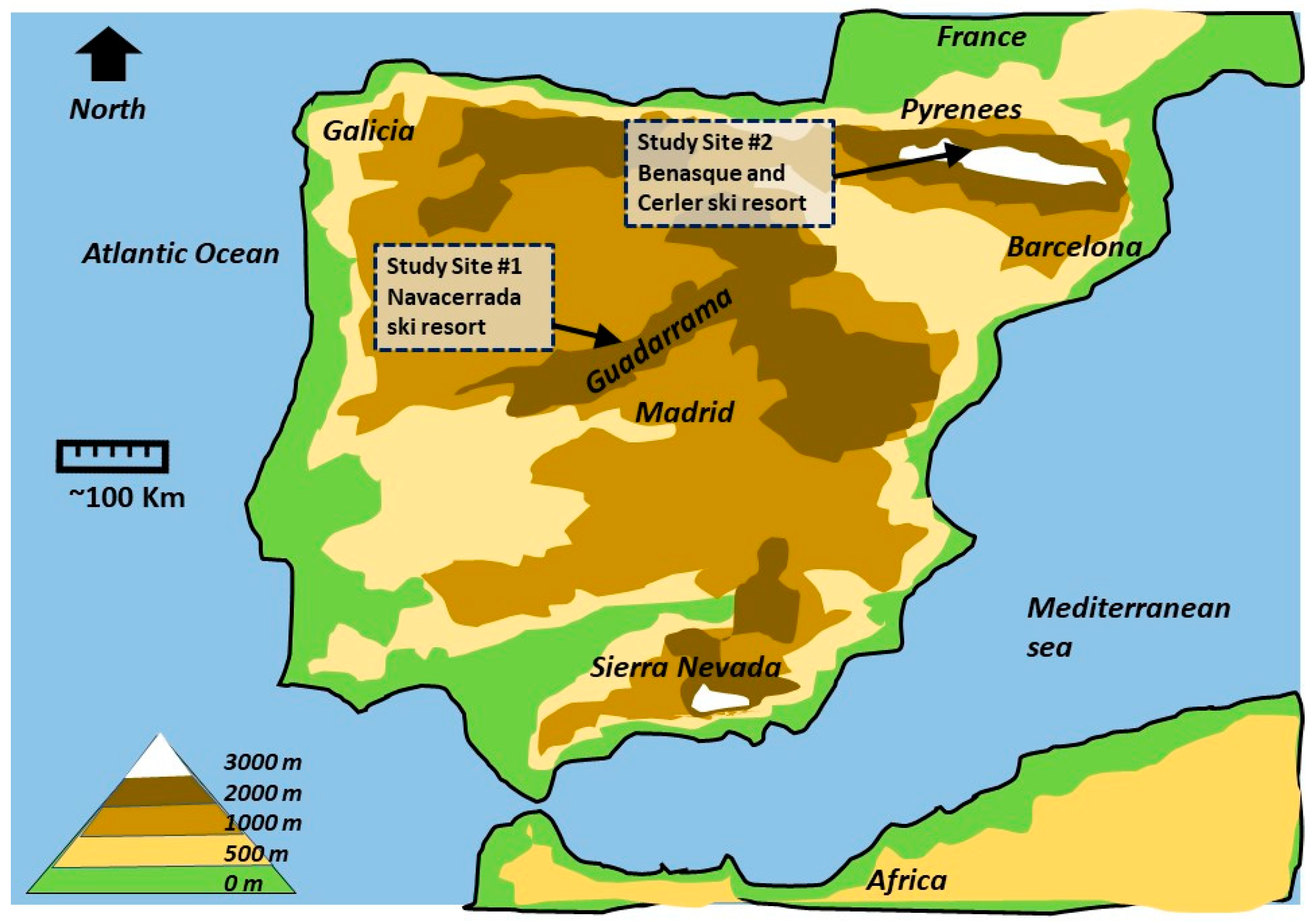
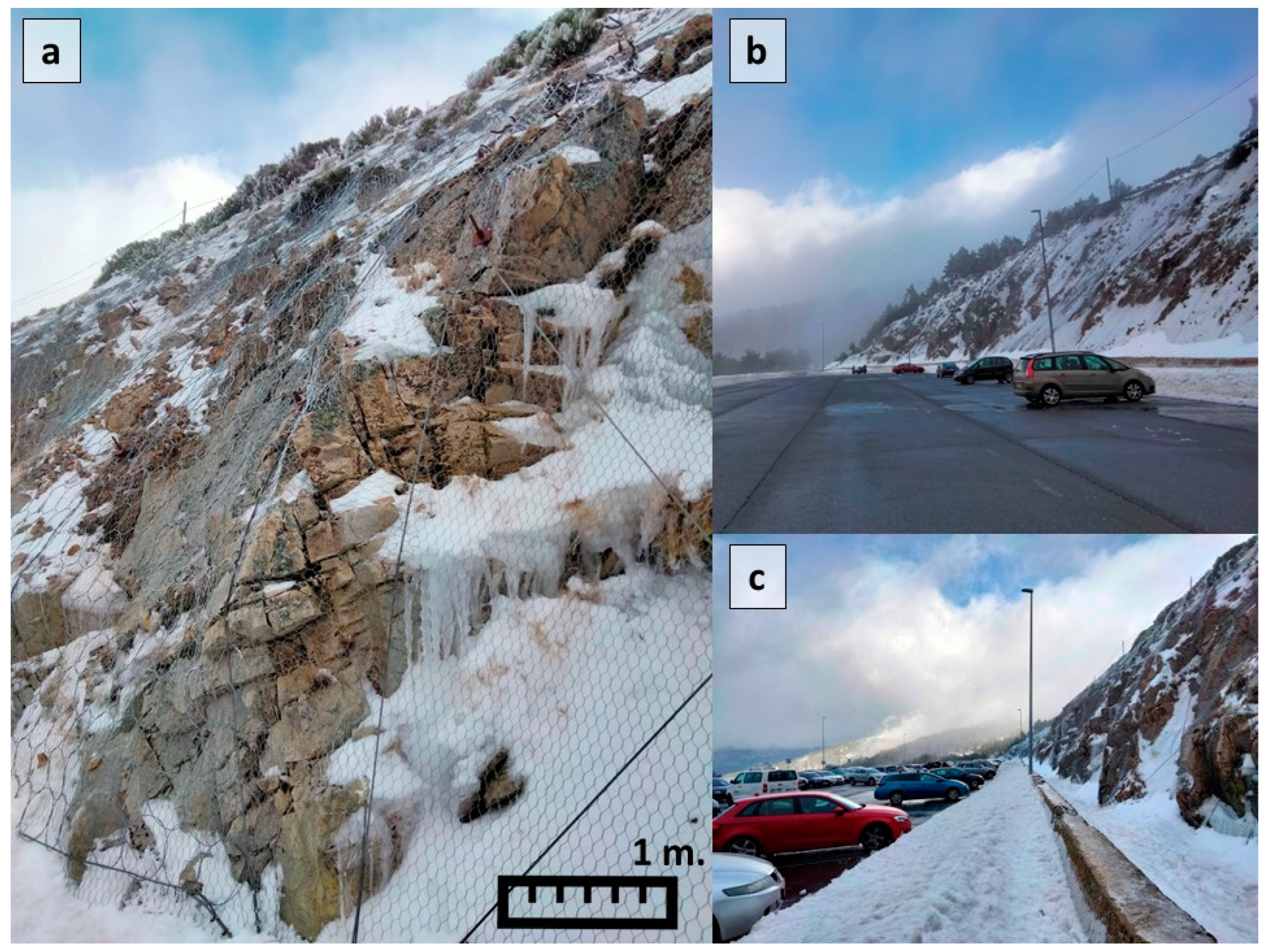
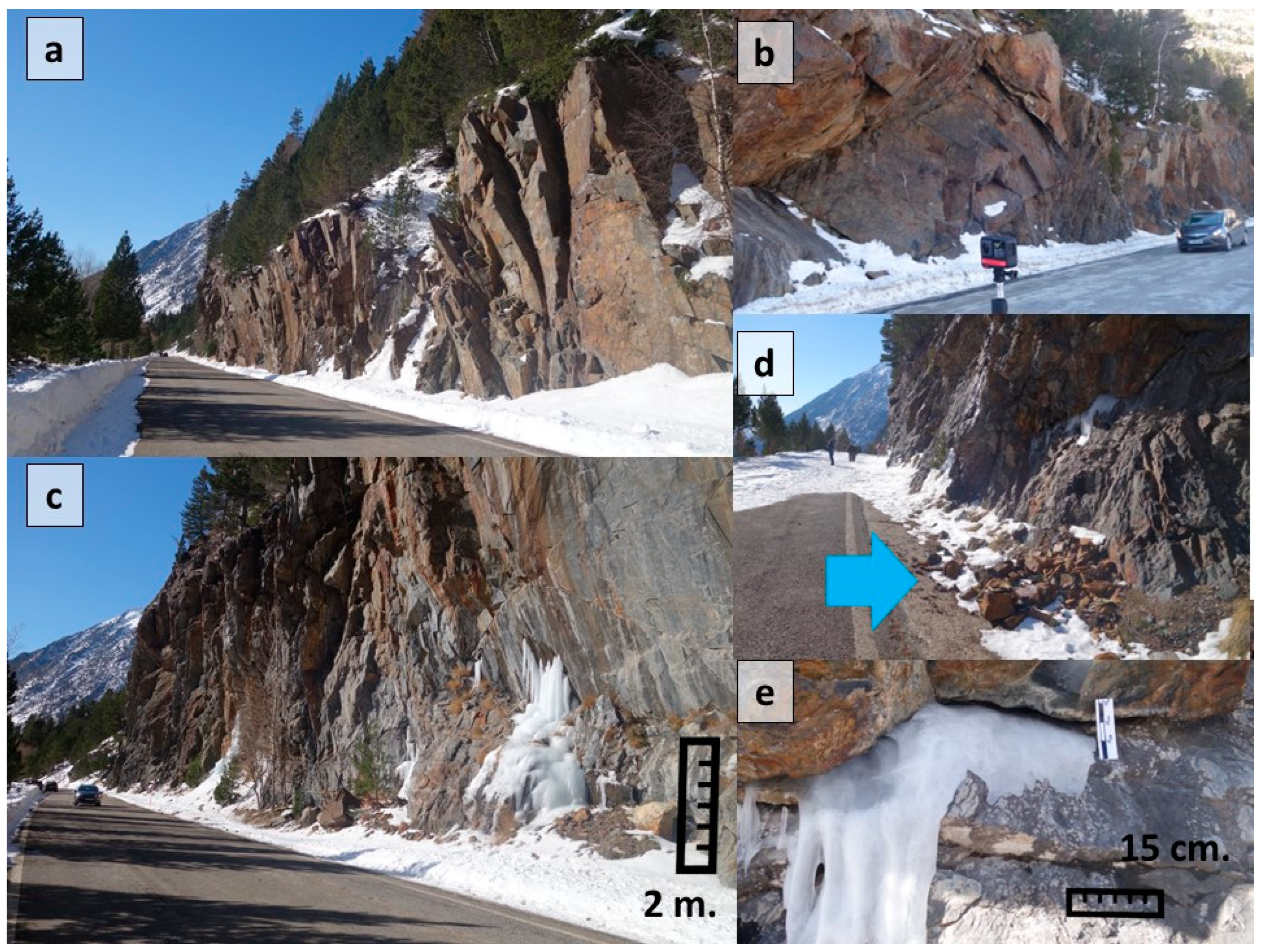

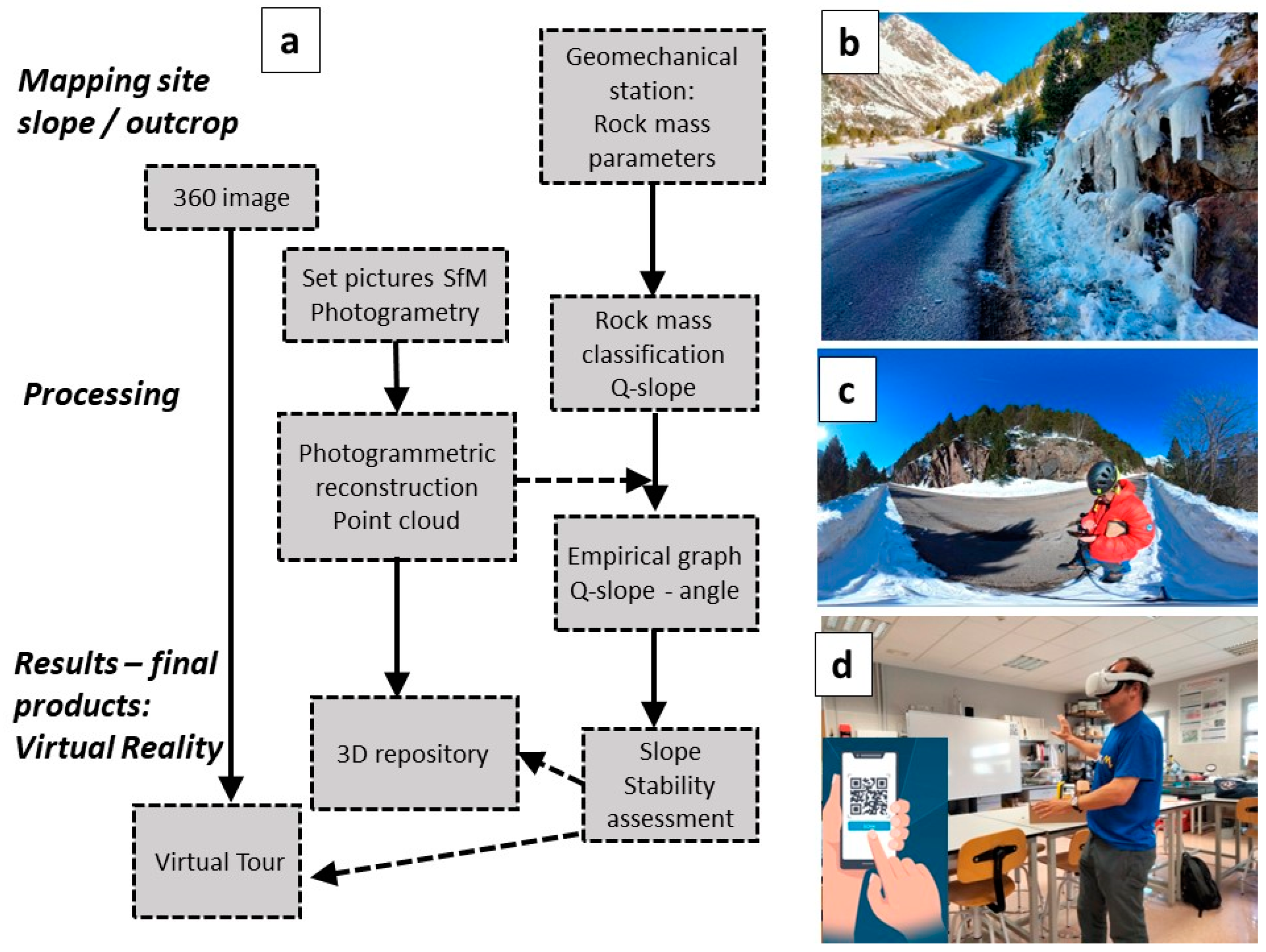

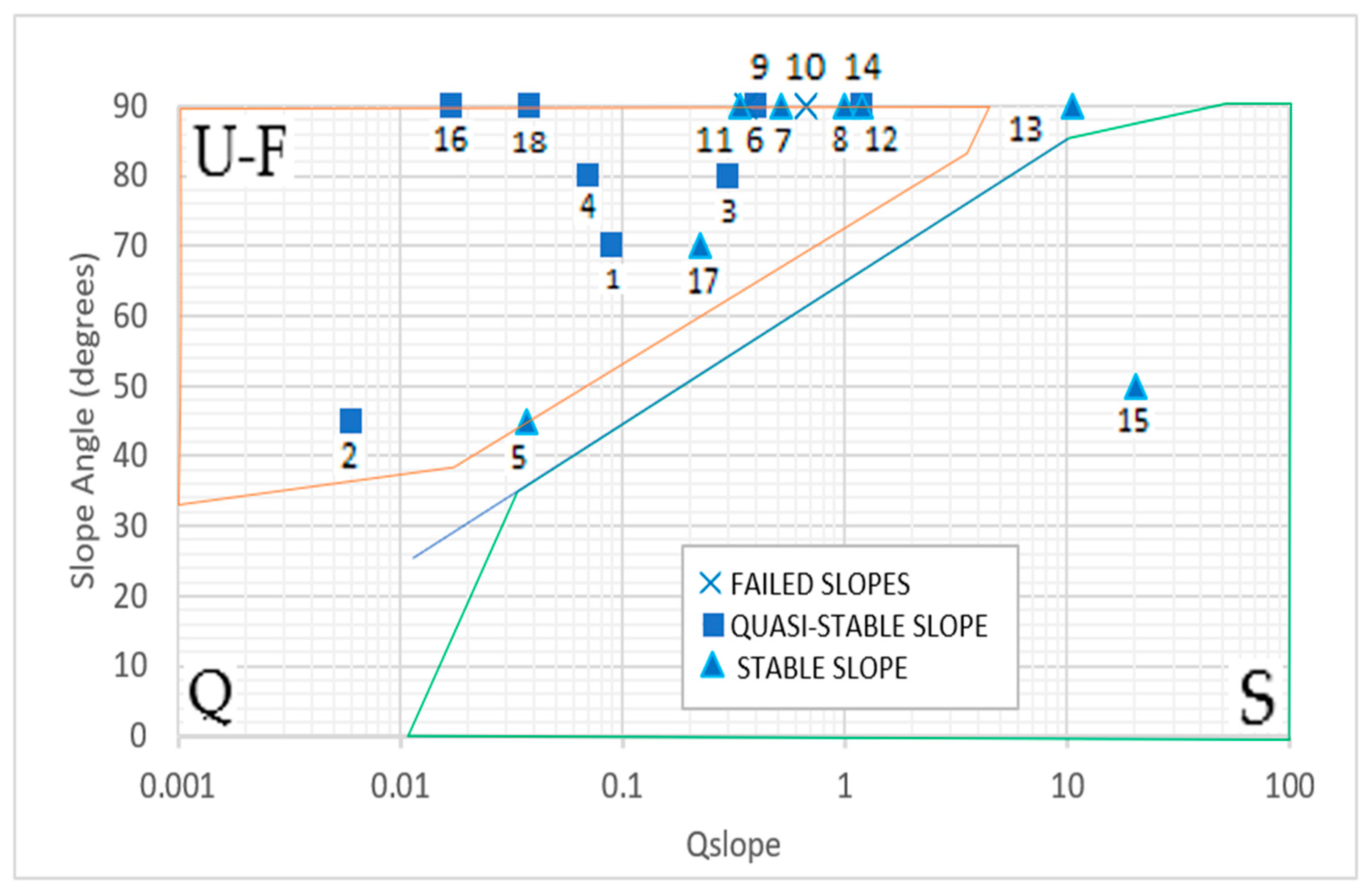
| Slope | Location | Altitude Meters a.s.l | Lithology | Slope Heigh (m) | Slope Angle ° | Field Work Date/h | Temperature °C | Slope Reinforcement (Mesh, Bolts…) | Ice Wedging–Ice Falls | |
|---|---|---|---|---|---|---|---|---|---|---|
| Minimum Night | During Measures | |||||||||
| 1 | Navacerrada carpark (Madrid) | 1849 | Granite | 15 m | 60–70° | 01/20/2023 15:00 | −7 °C | 2 °C | yes | yes |
| 2 | 1849 | Granite | 10 m | 45° | 01/20/2023 15:10 | −7 °C | 2 °C | yes | yes | |
| 3 | 1849 | Granite | 6 m | 80° | 01/20/2023 15:30 | −7 °C | 2 °C | yes | yes | |
| 4 | 1849 | Granite | 4–8 m | 70–80° | 01/20/2023 15:52 | −7 °C | 1 °C | yes | yes | |
| 5 | Morcuera (Madrid) | 1761 | Gneiss | 4–10 m | 20–45° | 01/20/2023 17:20 | −7 °C | 2 °C | No | Yes |
| 6 | Llanos del Hospital (Benasque) | 1778 | Slate | 8 m | 90–100° | 01/29/2023 12:20 | −12 °C | 0 °C | No | Yes |
| 7 | 1778 | Slate | 10 m | 90° | 01/29/2023 12:30 | −12 °C | 0 °C | No | Yes | |
| 8 | 1778. | Slate | 12 m | 90–100° | 01/29/2023 12:45 | −12 °C | 0 °C | No | Yes | |
| 9 | 1619 | Greywacke | 10 m | 90° | 01/29/2023 16:00 | −12 °C | 0 °C | No | Yes | |
| 10 | 1619 | Greywacke | 10 m | 90° | 01/29/2023 16:15 | −12 °C | 0 °C | No | Yes | |
| 11 | 1464 | Greywacke | 6 m | 90° | 01/29/2023 17:00 | −12 °C | 0 °C | No | Yes | |
| 12 | 1658 | Slate | 8 m. | 90° | 01/29/2023 10:00 | −7 °C | 0 °C | No | Yes | |
| 13 | Esera river bridge (Benasque) | 1246 | Slate | 6 m. | 90° | 01/31/2023 11:00 | −5 °C | 11 °C | No | Yes |
| 14 | 1246 | Slate | 8 m. | 90° | 01/31/2023 11:20 | −5 °C | 11 °C | No | Yes | |
| 15 | 1246 | Slate | 4 m. | 50° | 01/31/2023 11:35 | −5 °C | 11 °C | No | Yes | |
| 16 | La Piedad hermitage (Navarri) A139 road | 1005 | Marls and sandstones | 15 m. | 90–100° | 01/31/2023 12:30 | −5 °C | 6 °C | No | Yes |
| 17 | 1005 | Marls and sandstones | 15 m. | 70° | 01/31/2023 12:35 | −5 °C | 6 °C | No | Yes | |
| 18 | 1005 | Marls and sandstones | 15 m. | 90° | 01/31/2023 12:40 | −5 °C | 6 °C | No | Yes | |
| Study Site | Slope | Lithology | Q-Slope Calculation Factors | Q-Slope Ice | β (°) | Height (m) | Stability | |||||||
|---|---|---|---|---|---|---|---|---|---|---|---|---|---|---|
| RQD | Jn | Jr | Ja | O-Factor | Jwice | SRF Slope | Visual Perception (*) | Q-Slope Graph | ||||||
| Puerto Navacerrada Guadarrama | 1 | Granite | 55 | 9 | 1.5 | 4 | 0.5 | 0.3 × 1.3 | 5 | 0.09 | 60–70 | 15 | Q | U |
| 2 | 10 | 15 | 1.5 | 4 | 0.5 | 0.3 × 1.3 | 8 | 0.006 | 45 | 10 | Q | U | ||
| 3 | 40–70 | 12 | 1.5 | 4 | 1 | 0.9 × 1.3 | 5 | 0.3–0.5 | 80 | 6 | Q | U | ||
| 4 | 10–50 | 12 | 1.5 | 4 | 1 | 0.9 × 1.3 | 5 | 0.07–0.36 | 70–80 | 4 | Q | U | ||
| 5 | Gneiss | 20 | 9 | 1.5 | 3 | 1 | 0.5 | 15 | 0.037 | 30 | 8 | S | Q | |
| Benasque–Pyrenees | 6 | Slates and greywackes | 80 | 12 | 1 | 1 | 1 | 0.3 | 5 | 0.4 | 90–100 | 8 | Q | U |
| 7 | 70 | 12 | 1 | 2 | 1 | 0.9 | 5 | 0.52 | 90 | 10 | S | U | ||
| 8 | 100 | 9 | 1 | 2 | 1 | 0.9 | 5 | 1 | 90–100 | 12 | S | U | ||
| 9 | 100 | 15 | 1(1) * | 1(1) | 0.5 × 0.9 | 0.3 | 2.5 | 0.36 | 90 | 10 | U | U | ||
| 10 | 100 | 9 | 1 | 1 | 0.5 | 0.3 | 2.5 | 0.67 | 90 | 10 | U | U | ||
| 11 | 90 | 12 | 1.5 | 3 | 0.75 | 0.3 | 2.5 | 0.338 | 90 | 6 | S | U | ||
| 12 | 80 | 12 | 1.5 | 3 | 1 | 0.9 | 2.5 | 1.2 | 90 | 8 | S | U | ||
| 13 | slates | 70 | 9 | 3 | 2 | 1 | 0.9 | 1 | 10.5 | 90 | 6 | S | Q | |
| 14 | 80 | 9 | 3 | 2 | 0.75 | 0.3 | 2.5 | 1.2 | 90 | 8 | Q | U | ||
| 15 | 80 | 4 | 3 | 2 | 0.75 | 0.9 | 1 | 20.25 | 50 | 4 | S | S | ||
| 16 | marls | 10–50 | 9 | 1 | 4 | 1 | 0.3 | 5 | 0.017 | 90–100 | 15 | Q | U | |
| 17 | 10–50 | 4 | 1 | 4 | 1 | 0.9 | 2.5 | 0.225 | 70 | 15 | S | U | ||
| 18 | 10–50 | 4 | 1 | 4 | 1 | 0.3 | 5 | 0.038 | 90 | 15 | Q | U | ||
| Web Link or/and QR Code | Type of Platform | Number of Images–Scenes | Sites Covered | Virtual Data Gathering–Pop-Ups Menus |
|---|---|---|---|---|
| https://edu.cospaces.io/GYJ-RVV | Tour–virtual reality field trip | 4 | Navacerrada and Benasque | yes |
https://sketchfab.com/3d-models/slope-9-benasque-cfa3fe8a2d534b9ebdc6fe093d8901df | Repository 3D image | 1 | Benasque | Not yet |
https://sketchfab.com/3d-models/slope-6-and-7-benasque-d779f38842864224b3a4d56ed43f7324 | Repository 3D image | 1 | Benasque | Not yet |
Disclaimer/Publisher’s Note: The statements, opinions and data contained in all publications are solely those of the individual author(s) and contributor(s) and not of MDPI and/or the editor(s). MDPI and/or the editor(s) disclaim responsibility for any injury to people or property resulting from any ideas, methods, instructions or products referred to in the content. |
© 2023 by the authors. Licensee MDPI, Basel, Switzerland. This article is an open access article distributed under the terms and conditions of the Creative Commons Attribution (CC BY) license (https://creativecommons.org/licenses/by/4.0/).
Share and Cite
Bernal, C.P.B.; Jordá Bordehore, L. Application of the Q-Slope Empirical Approach for Slope Stability Assessment of Spanish Mountain Roads in Winter—Combining Remote Techniques with Virtual Reality. Sustainability 2023, 15, 15744. https://doi.org/10.3390/su152215744
Bernal CPB, Jordá Bordehore L. Application of the Q-Slope Empirical Approach for Slope Stability Assessment of Spanish Mountain Roads in Winter—Combining Remote Techniques with Virtual Reality. Sustainability. 2023; 15(22):15744. https://doi.org/10.3390/su152215744
Chicago/Turabian StyleBernal, Cesar Patricio Borja, and Luis Jordá Bordehore. 2023. "Application of the Q-Slope Empirical Approach for Slope Stability Assessment of Spanish Mountain Roads in Winter—Combining Remote Techniques with Virtual Reality" Sustainability 15, no. 22: 15744. https://doi.org/10.3390/su152215744







